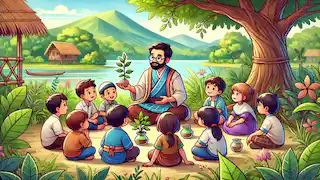Pi, short for Piyun, was a young Native boy growing up in the heart of Canada. His life was a tapestry woven with the rich traditions of his ancestors, the vibrant natural world around him, and the modern challenges of the 21st century. This is a story of his journey through the intricate dance of tradition and change. Pi was born into the Anishinaabe community, a people known for their deep connection to the land and their rich cultural heritage. His family lived in a small village nestled by the serene waters of a great lake, surrounded by dense forests. Pi's parents, Nokomis and Mishibizhiw, named him Piyun, which means 'spirit' in their native tongue. They hoped he would grow up with a strong spirit, able to face the challenges of life with courage and wisdom. From a young age, Pi was enchanted by the stories his grandmother told. She spoke of the great spirit beings that watched over their people, the animals that were their brothers and sisters, and the sacredness of the land. Pi's eyes would light up with wonder as he listened to tales of Nanabozho, the trickster hero, and Gitchi Manitou, the Great Spirit. Pi's education was not confined to the classroom. He learned the traditional ways from the Elders of his community. They taught him how to fish in the clear waters of the lake, how to track animals in the forest, and the medicinal uses of the plants that grew around them. These lessons were more than practical skills; they were a connection to his heritage, a way of understanding his place in the world. As Pi grew older, he became increasingly aware of the tension between the traditional ways and the encroaching modern world. The village had a small school where he learned English, mathematics, and science. While Pi excelled academically, he often felt torn between two worlds. His heart belonged to the land and the traditions of his people, but his mind was curious about the wider world beyond the forest. One summer, when Pi was thirteen, he embarked on a personal quest. He decided to spend a month alone in the forest, a rite of passage that many of his ancestors had undertaken. This journey was a time for reflection, growth, and connection with the spiritual world. Nokomis and Mishibizhiw supported his decision, though they worried for his safety. With only a small backpack containing some essentials, Pi ventured into the forest. The first few days were a mix of excitement and fear. He set up a small camp by a stream and spent his days exploring the forest, practicing the skills the Elders had taught him. At night, he sat by the fire, listening to the sounds of the wilderness and thinking about the stories of his ancestors. Pi's time in the forest was filled with encounters that deepened his understanding of nature. He watched as a family of beavers built a dam, marveled at the sight of an eagle soaring above, and felt a kinship with a curious fox that visited his camp each evening. Each experience was a lesson, a reminder of the interconnectedness of all life. One night, as Pi lay beneath the stars, he felt a profound sense of peace. He closed his eyes and drifted into a deep sleep. In his dream, he saw Nanabozho, the trickster hero, who spoke to him in a language that transcended words. Nanabozho told Pi that he was destined to be a bridge between the old ways and the new, to bring the wisdom of his ancestors into the modern world. When Pi returned to his village, he was greeted with joy and relief. He shared the stories of his journey with the Elders and his family. They listened intently, sensing that Pi had undergone a significant transformation. Pi felt more connected to his heritage than ever before, but he also felt a new sense of purpose. Pi's experience in the forest taught him that it was possible to honor his traditions while embracing the future. He continued his education, excelling in his studies, but he also remained deeply involved in his community. He participated in ceremonies, helped the Elders, and shared the knowledge he had gained with the younger children. As Pi grew into adulthood, he began to see his role more clearly. He decided to pursue a career in environmental science, hoping to use his knowledge to protect the natural world that his people held sacred. He believed that science and tradition could work together to create a sustainable future. Pi's transition to university was challenging but rewarding. He moved to a city far from his village, where he encountered diverse perspectives and ideas. While he missed the forest and his family, he found a new community of like-minded individuals who shared his passion for the environment. During his time at university, Pi became involved in environmental advocacy. He joined a student group dedicated to raising awareness about climate change and the importance of preserving natural habitats. Pi's unique perspective, rooted in his Native heritage, brought a valuable voice to the movement. Pi's advocacy work led him to collaborate with Indigenous groups from across Canada. He attended conferences, spoke at events, and worked on projects that aimed to integrate traditional ecological knowledge with modern science. His efforts were widely recognized, and he became a respected figure in the environmental community. After completing his degree, Pi returned to his village with a renewed sense of purpose. He applied his knowledge to local conservation efforts, working with the Elders to protect the forest and the lake. Pi's work helped to strengthen the community's resilience in the face of environmental challenges. Pi also took on the role of educator, teaching the children of his village about the importance of preserving their heritage and the environment. He used both traditional stories and scientific knowledge to inspire them, hoping to instill in them the same sense of wonder and responsibility that had guided him. Pi's journey from a curious boy to a dedicated environmentalist was a testament to the power of bridging cultures. He showed that it was possible to honor one's roots while embracing the future, to learn from the past while working towards a better tomorrow. His story inspired many in his community and beyond, leaving a lasting legacy of harmony between tradition and progress. The life of Pi is a rich tapestry of tradition, discovery, and resilience. His journey illustrates the power of embracing both heritage and innovation, showing that the wisdom of the past can guide us towards a sustainable future. Pi's story is a reminder that we are all connected, and that by honoring our roots, we can create a better world for generations to come.Pi's Roots
A Childhood in the Forest
Learning from the Elders
Challenges of the Modern World
A Personal Quest

The Journey Begins
Encounters with Nature
A Spiritual Awakening

Returning Home
Balancing Two Worlds
A New Vision
University Life

Advocacy and Activism
Connecting Cultures
A Return to the Village
Teaching the Next Generation

A Legacy of Harmony
Conclusion
Life of Pi
Reading Time: 7 min

About Story: Life of Pi is a Realistic Fiction Stories from canada set in the Contemporary Stories. This Descriptive Stories tale explores themes of Coming of Age Stories and is suitable for All Ages Stories. It offers Cultural Stories insights. The inspiring journey of a Native boy balancing tradition and modernity.


















